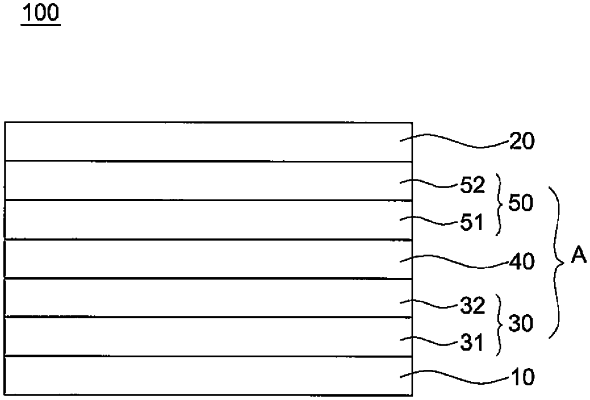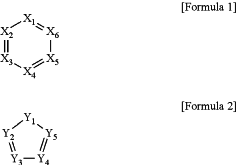| CPC H01L 51/0067 (2013.01) [H01L 51/001 (2013.01); H01L 51/0054 (2013.01); H01L 51/0058 (2013.01); H01L 51/0072 (2013.01); H01L 51/0073 (2013.01); H01L 51/5004 (2013.01); H01L 51/504 (2013.01); H01L 51/5016 (2013.01); H01L 51/56 (2013.01)] | 19 Claims |

|
1. An organic electroluminescent device, comprising:
an anode; a hole transporting area; an emissive layer; an electron transporting area, and a cathode, which are stacked in this order,
wherein the emissive layer includes a host,
wherein the electron transporting area includes a first layer and a second layer, and
wherein the first layer of the electron transporting area, which is in contact with the emissive layer, is an exciton confinement layer, and a density of states for LUMO (DOSLUMOECL) of the exciton confinement layer satisfies at least one or more of the following conditions (i) and (ii):
(i) the density of states for LUMO (DOSLUMOECL) of the exciton confinement layer having a DOS that overlaps more than 0% of a density of states for LUMO (DOSLUMOHOST) of the host; and
(ii) the density of states for LUMO (DOSLUMOECL) of the exciton confinement layer having a DOS that overlaps more than 0% of a density of states for LUMO (DOSLUMOET) of the second layer of the electron transporting area except the exciton confinement layer,
wherein the exciton confinement layer comprises at least one EWG moiety of a 6-membered moiety represented by the following Formula 1; a 5-membered moiety represented by the following Formula 2; or a polycyclic moiety in which the 6-membered moiety and the 5-membered moiety are condensed,
 in Formula 1 or 2, X1 to X6 and Y1 to Y5 may be the same as or different from each other, each independently being N or C(R), while at least one of X1 to X6 and Y1 to Y5 is N,
when C(R) is plural in number, the plurality of R may be the same as or different from each other, each independently being selected from the group consisting of: hydrogen, deuterium, a halogen group, a cyano group, a nitro group, an amino group, a C1 to C40 alkyl group, a C2 to C40 alkenyl group, a C2 to C40 alkynyl group, a C3 to C40 cycloalkyl group, a heterocycloalkyl group having 3 to 40 nuclear atoms, a C6 to C60 aryl group, a heteroaryl group having 5 to 60 nuclear atoms, a C1 to C40 alkyloxy group, a C6 to C60 aryloxy group, a C1 to C40 alkylsilyl group, a C6 to C60 arylsilyl group, a C1 to C40 alkylboron group, a C6 to C60 arylboron group, a C6 to C60 arylphosphine group, a C6 to C60 arylphosphine oxide group and a C6 to C60 arylamine group, or may be bonded with an adjacent group to form a condensed ring,
the alkyl group, the alkenyl group, the alkynyl group, the aryl group, the heteroaryl group, the aryloxy group, the alkyloxy group, the cycloalkyl group, the heterocycloalkyl group, the arylamine group, the alkylsilyl group, the alkylboron group, the arylboron group, the arylphosphine group, the arylphosphine oxide group, and the arylamine group of R may each independently be substituted or unsubstituted with one or more kinds of sub stituents selected from the group consisting of hydrogen, deuterium (D), halogen, a cyano group, a nitro group, a C1 to C40 alkyl group, a C2 to C40 alkenyl group, a C2 to C40 alkynyl group, a C3 to C40 cycloalkyl group, a heterocycloalkyl group having 3 to 40 nuclear atoms, a C6 to C60 aryl group, a heteroaryl group having 5 to 60 nuclear atoms, a C1 to C40 alkyloxy group, a C6 to C60 aryloxy group, a C1 to C40 alkylsilyl group, a C6 to C60 arylsilyl group, a C1 to C40 alkylboron group, a C6 to C60 arylboron group, a C6 to C60 arylphosphine group, a C6 to C60 arylphosphine oxide group and a C6 to C60 arylamine group, and when the substituents are plural in number, the substituents may be the same as or different from each other.
|